Table of Contents
ToggleSurya Namaskara, also known as Sun Salutation, is a popular sequence of yoga asanas (postures) performed in a particular order to pay homage to the sun. The practice involves a series of 12 different surya namaskar poses, each synchronised with breath, and performed in a flowing sequence.
Surya Namaskara is traditionally performed in the morning, facing the rising sun, but it can also be practised at any time of the day as a complete exercise routine. The practice of Surya Namaskara has many benefits, including strengthening and stretching the muscles, increasing flexibility, improving digestion, and calming the mind.
How to prepare for Surya Namaskar?
Surya namaskara requires bending and stretching hence most beginners find it difficult to perform the asanas due to stiffness in their body. Therefore each asana must be practised slowly till it is mastered. There are certain points to be remembered while preparing for surya namaskara. These are;
- The stomach should be empty before doing the surya namaskara.
- One should have a bath before offering the prayers to the sun.
- Should wear loose clothes so that the sun rays can fall on the body.
- The place for surya namaskar should be chosen with care. There should be fresh air and sunlight even if it is performed in a room. Clean open space or a garden is always better.
- Should use a clean mat
- One should face east while doing surya namaskar to get maximum benefit from the sun rays.
- Focus not only on posture but also on the breathing which is an integral part of surya namaskar.
- Mind should be completely relaxed and focussed while doing surya namaskar
- Each movement should be performed with minimum effort using only the muscles required for a particular posture, while the rest of the body should remain completely relaxed.
- One may learn the twelve surya mantras and chant them while doing surya namaskar to get better results.
Also Read: How Suryanamaskar Affects Our Health And Mind
12 Asanas of Surya Namaskar with Poses
- Pranamasana (Prayer pose)
- Hasta Uttanasana (Raised Arms pose)
- Hasta Padasana (Standing Forward Bend)
- Ashwa Sanchalanasana (Equestrian pose)
- Parvatasana/Bhadrasana (Mountain Pose)
- Ashtanga Namaskara (Salute with Eight Limbs pose)
- Bhujangasana (Cobra pose)
- Parvatasana (Mountain pose)
- Ashwa Sanchalanasana (Equestrian pose)
- Hasta Padasana (Standing Forward Bend)
- Hasta Uttanasana (Raised Arms pose)
- Pranamasana (Prayer pose)
Step 1: Pranamasana / Namaskarasana (Prayer pose)
- Stand Straight with feet together firmly balancing the body weight equally on both feet.
- Relax the shoulders. Breathe in and lift both the arms up.
- While exhaling, bring the palms in front of the chest in the prayer position with fingertips pointing upwards.
- The hands should be held at the Anahata chakra against the sternum.
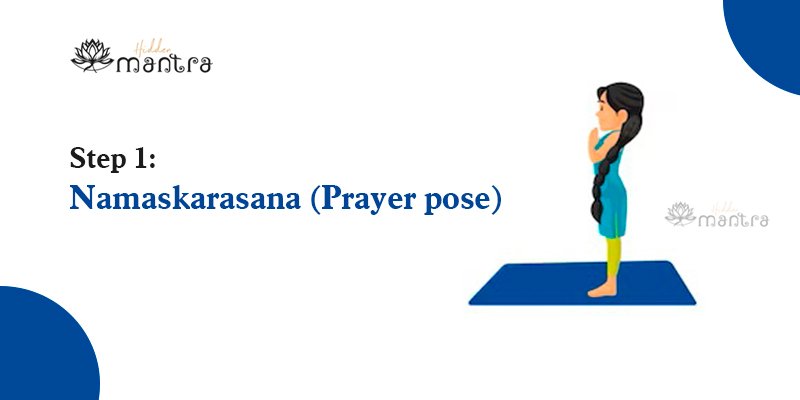
Step 2: Hasta Uttanasana (Raised Arms pose)
- Breathe in and lift the arms up and back
- Keep the biceps close to the ears
- Stretch the whole body upwards
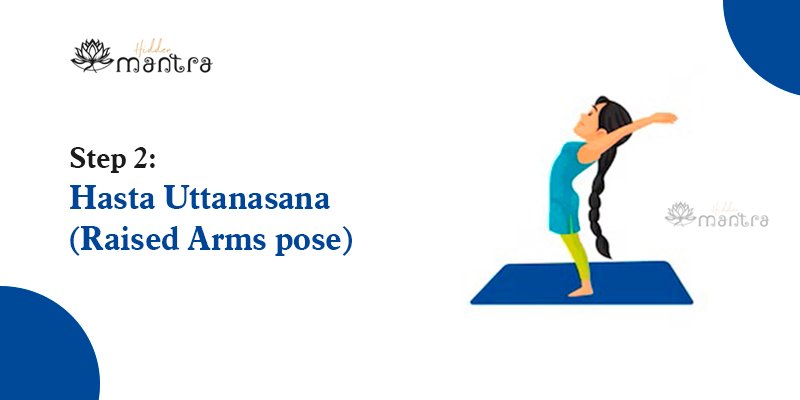
Step 3: Hasta Padasana (Standing Forward Bend)
- Breathe out and blend forward from the waist.
- Exhale and bring the hands down and place the palms flat on the floor
- Take care not to bend the knee. Try to touch the knees with your forehead and feel the stretch in your leg and back muscles.

Step 4: Ashwa Sanchalanasana (Equestrian pose)
- Breathe in and push the right leg back as far as possible bringing the right knee to the floor.
- The left foot should be placed between the palms
- Stretching should be smooth. Do not stress spine too much
- Bring the pelvis forward, arch our spine and look up

Step 5: Parvatasana/Bhadrasana (Mountain Pose)
- Breath out. Lift your hips and tailbone up
- Exhale and push your hips upwards. The body now forms an inverted V shaped structure.
- Keep the elbows and knees straight. Stretch your head in the direction of the knees with your chin touching the chest.

Step 6: Ashtanga Namaskara (Salute with Eight Limbs pose)
- Bring knees down to the floor and exhale
- Lie straight on the stomach with the chest and chin touching the floor
- Place your palms next to the shoulders on the floor
- Raise your posterior slightly upwards
- Your two hands, two feet, two knees, chest and chin. These eight parts of your body should touch the floor.
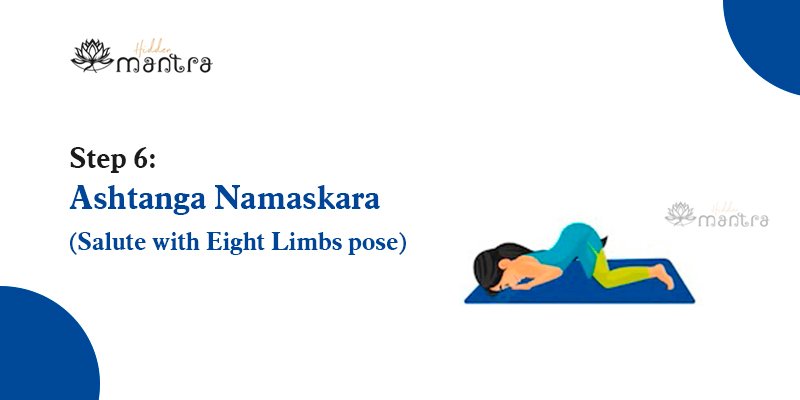
Step 7: Bhujangasana (Cobra pose)
- Slide forward and lie straight on the stomach
- Place your hand next to the shoulders
- Inhale and lift the upper body upto your navel. Relax your shoulders and lookup
- Continue taking long and deep breaths for a few seconds. Avoid over arching the neck and lower back.
- Exhale and slowly return to the resting position
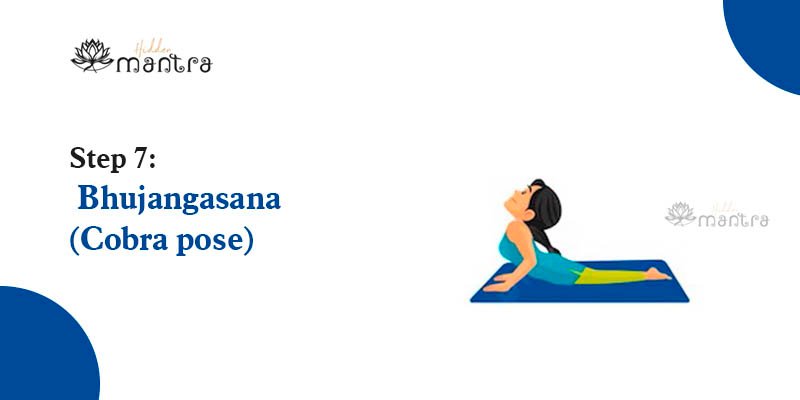
Step 8: Parvatasana (Mountain pose) Same as step 5
- Breath out. Lift your hips and tailbone up
- Exhale and push your hips upwards. The body now forms an inverted V shaped structure.
- Keep the elbows and knees straight. Stretch your head in the direction of the knees with your chin touching the chest.
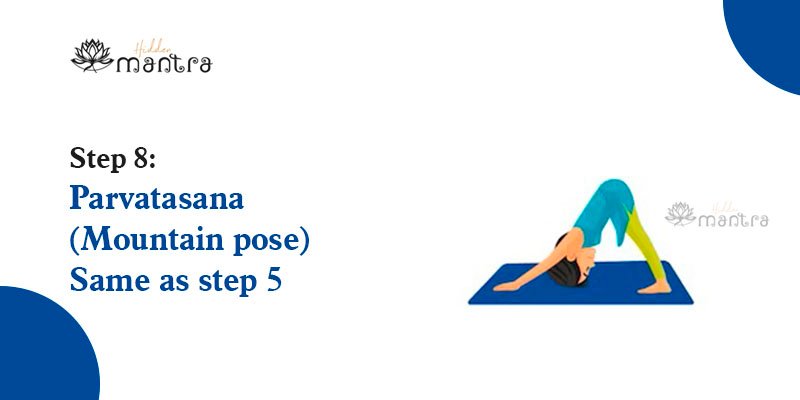
Step 9: Ashwa Sanchalanasana (Equestrian pose)Same as step 4
- Breathe in and push the right leg back as far as possible bringing the right knee to the floor.
- The left foot should be placed between the palms
- Stretching should be smooth. Do not stress spine too much
- Bring the pelvis forward, arch our spine and look up
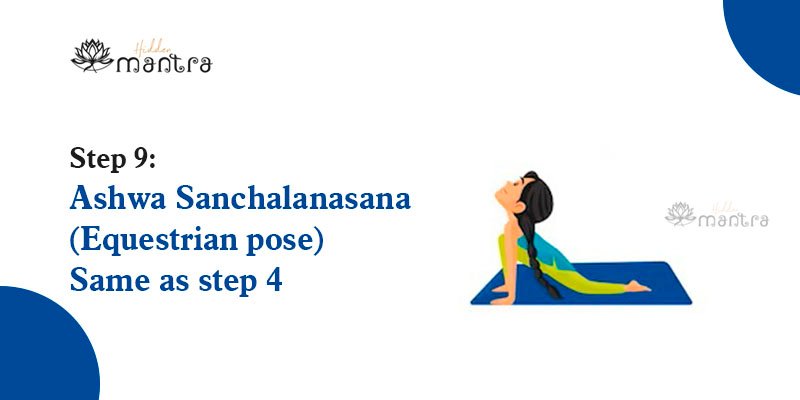
Step 10: Ashwa Sanchalanasana (Equestrian pose)Same as step 3
- Breathe out and blend forward from the waist.
- Exhale and bring the hands down and place the palms flat on the floor
- Take care not to bend the knee. Try to touch the knees with your forehead and feel the stretch in your leg and back muscles.

Step 11: Ashwa Sanchalanasana (Equestrian pose)Same as step 2
- Breathe in and lift the arms up and back
- Keep the biceps close to the ears
- Stretch the whole body upwards
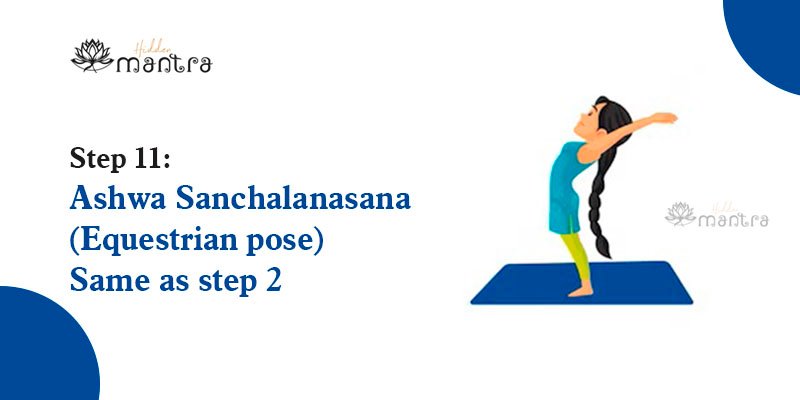
Step 12: Ashwa Sanchalanasana (Equestrian pose) Same as step 1
- Stand Straight with feet together firmly balancing the body weight equally on both feet.
- Relax the shoulders. Breathe in and lift both the arms up.
- While exhaling, bring the palms in front of the chest in the prayer position with fingertips pointing upwards.
- The hands should be held at the Anahata chakra against the sternum.

Surya Namaskar: 12 Steps with Video Explanation
Discover the hidden gems of Surya Namaskar by watching our meticulously crafted video. This visual masterpiece is designed to help you understand and execute each step with precision. Whether you’re a beginner looking to start your day with positivity or a seasoned yogi seeking to enhance your practice, our video is your ultimate guide.
Benefits of Surya Namaskara
Let’s explore the numerous benefits of Surya Namaskar. If you want to learn more about How Suryanamaskar Affects Our Health And Mind, read our blog about suryanamaskar . It will provide you with new insights.

- Increases flexibility: The sequence of asanas in Surya Namaskara helps to stretch and tone the muscles, thereby increasing flexibility and range of motion.
- Boosts metabolism: Surya Namaskar is a complete exercise routine that can help to increase metabolism, which can aid in weight loss and improve overall health.
- Improves cardiovascular health: The dynamic movements of Surya Namaskar can help to improve cardiovascular health by increasing blood circulation and oxygenation.
- Reduces stress and anxiety: The practice of Surya Namaskar can help to calm the mind and reduce stress and anxiety.
- Strengthens the body: The asanas in Surya Namaskar work to strengthen the muscles, joints, and bones, thereby promoting overall strength and stability.
- Improves digestion: The practice of Surya Namaskar can help to improve digestion and alleviate digestive issues.
- Enhances overall well-being: Surya Namaskar is a complete exercise routine that benefits the entire body, mind, and spirit, thereby promoting overall well-being and vitality.
FAQ
What are the 12 steps of Surya Namaskar?
1.Pranamasana (Prayer pose)
2.Hasta Uttanasana (Raised Arms pose)
3.Hasta Padasana (Standing Forward Bend)
4.Ashwa Sanchalanasana (Equestrian pose)
5.Parvatasana/Bhadrasana (Mountain Pose)
6.Ashtanga Namaskara (Salute with Eight Limbs pose)
7.Bhujangasana (Cobra pose)
8.Parvatasana (Mountain pose)
9.Ashwa Sanchalanasana (Equestrian pose)
10.Hasta Padasana (Standing Forward Bend)
11.Hasta Uttanasana (Raised Arms pose)
12.Pranamasana (Prayer pose)
How many Surya Namaskar should be done in a day?
The number of Surya Namaskar (Sun Salutations) that should be done in a day depends on various factors such as an individual’s fitness level, experience with yoga, and overall health.
As a general guideline, beginners may start with 2-3 rounds of Surya Namaskar and gradually increase the number of rounds over time. Intermediate or advanced practitioners may aim for 12-24 rounds or more, depending on their physical capacity.
It is important to listen to your body and not push beyond your limits. Practising Surya Namaskar regularly, even in small numbers, can provide many benefits for physical and mental well-being. It is always recommended to consult with a certified yoga instructor before starting any new yoga practice.
What are the benefits of Surya Namaskar?
Surya Namaskar (Sun Salutation) is a series of yoga postures that can provide numerous benefits for the mind, body, and soul. Here are the top 5 benefits of practising Surya Namaskar regularly:
Increases Flexibility
Boosts Cardiovascular Health
Reduces Stress and Anxiety
Improves Digestion
Enhances Overall Health
What happens if you do 12 Surya Namaskar everyday?
Practising 12 rounds of Surya Namaskar (Sun Salutations) every day can provide various benefits for physical and mental health. Here are some possible outcomes of practising 12 Surya Namaskar rounds daily:
Improved Physical Fitness: Practising 12 rounds of Surya Namaskar daily can provide a moderate cardiovascular workout that can improve overall physical fitness. The practice can increase strength, flexibility, endurance, and balance.
Increased Energy and Vitality: Surya Namaskar is known to activate the solar plexus, which is the centre of energy in the body. Regular practice can increase energy levels and promote a sense of vitality and well-being.
Better Sleep Quality: Practising Surya Namaskar can help reduce stress and promote relaxation, which can improve the quality of sleep. Regular practice can help regulate the sleep-wake cycle and promote restful sleep.
Weight Management: Surya Namaskar can help burn calories and promote weight loss. Practising 12 rounds of Surya Namaskar daily, in combination with a healthy diet and lifestyle, can aid in weight management.
Reduced Stress and Anxiety: Surya Namaskar involves synchronised breathing and mindful movement, which can help reduce stress and anxiety. Regular practice can promote relaxation, improve mental clarity, and enhance overall well-being.
Does Surya Namaskar burn belly fat?
Practising Surya Namaskar (Sun Salutation) regularly can contribute to weight loss and aid in reducing belly fat. However, it is important to understand that targeting specific body parts for fat loss is not possible through exercise alone.
Surya Namaskar can help burn calories, promote metabolism, and improve overall fitness levels, which can contribute to weight loss and a reduction in belly fat. It is also important to maintain a healthy diet and lifestyle in conjunction with regular exercise to achieve weight loss goals.
How many calories are burned in 1 full Surya Namaskar?
The number of calories burned during one full round of Surya Namaskar (Sun Salutation) can vary depending on several factors, such as body weight, age, fitness level, and the intensity of the practice.
On average, one round of Surya Namaskar can burn approximately 7-10 calories for a person weighing around 60-70 kg (132-154 lbs). This means that practising 12 rounds of Surya Namaskar can burn approximately 84-120 calories.
It is always recommended to consult with a certified yoga instructor before starting any new yoga practice and to listen to your body while practising to avoid any injury or strain.









